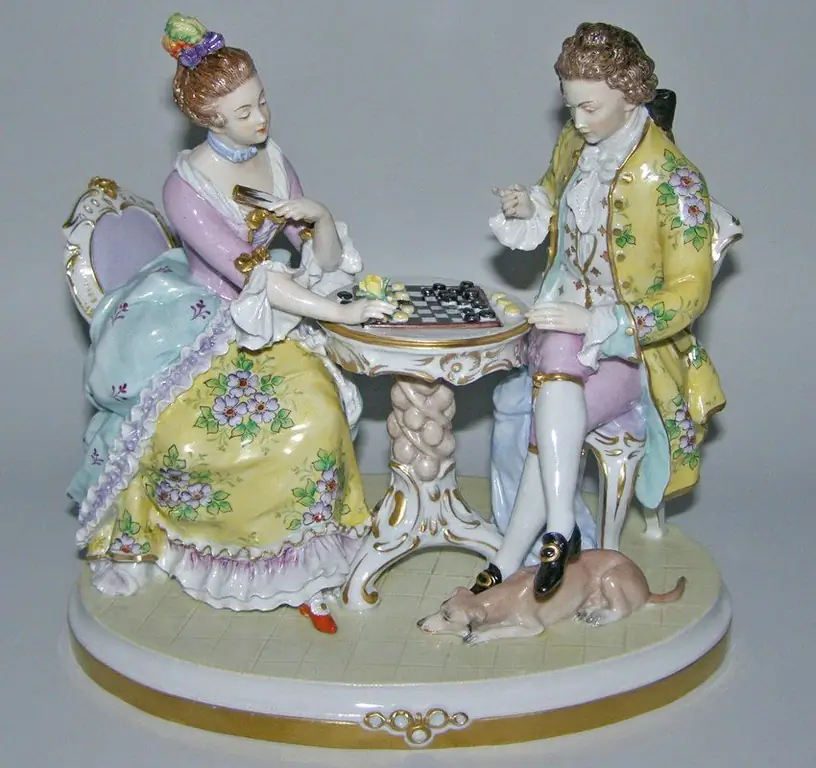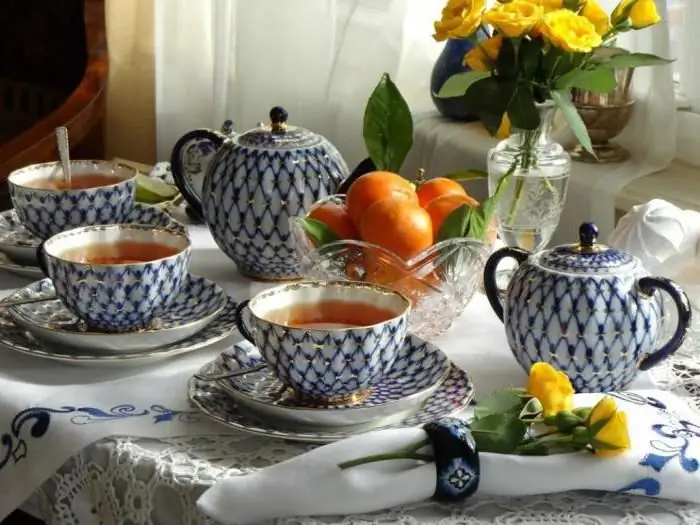2026 Author: Howard Calhoun | [email protected]. Last modified: 2025-01-24 13:10:43
The history of the development of the porcelain and faience industry in Russia has more than 250 years. During this time, she experienced both ups and downs. Lomonosov Porcelain Factory is the oldest enterprise in this industry in the country. It operates today, but under a different name.
What is the history of the Lomonosov Porcelain Factory? What products does he produce today? You will learn about this from our article.
Porcelain of Russia: the history of the industry
Durable, resistant to various influences and beautiful in appearance, a material called porcelain has long been used for the production of dishes and interior items. It is based on four natural components: kaolin, quartz, clay and feldspar. The first "formula" of porcelain was brought out by the Chinese in the 7th century. The recipe for its production became known to Europeans much later - only at the beginning of the 18th century.
The first porcelain manufactory in the Russian Empire appeared in 1744 in St. Petersburg. This is precisely the Lomonosov Porcelain Factory. True, today it has a different name - Imperial.
The porcelain and faience industry of Russia reached an unprecedented development in the era of the USSR. At that time inWithin our country, there were about 80 enterprises in this industry that produced products mainly for mass consumption. Unfortunately, today only three porcelain factories are fully operational in Russia.
Lomonosov Porcelain Factory, St. Petersburg: history and hallmarks
The oldest porcelain factory in Russia is located in the city of St. Petersburg. The year of its foundation is 1744.
Initially, the company was called the Neva Porcelain Manufactory. From the middle of the 18th century until 1917, the plant was called the Imperial, and after the revolution - the State. In 1925, it received a new name: the Leningrad Porcelain Factory named after M. V. Lomonosov. An abbreviated version of the LFZ has survived to this day. In 2005, the plant again became known as the Imperial.

A museum was established at the plant at the end of the 19th century. By order of Tsar Alexander III, each order from the imperial family had to be made in two copies - one of them was left in this museum. Thus, his collections were steadily and regularly replenished with new works. The Soviet authorities preserved the museum at the LFZ. Moreover, during the Second World War, all of his collections were evacuated to the city of Irbit in the Urals.
In Soviet times, the Leningrad Porcelain Factory was reoriented to the production of medium quality mass products. The enterprise produced dishes, tea sets and figurines in huge quantities. In the 1920s and 1930s, famous Soviet artists worked at the plant: Ilya Chashnik, Nikolai Suetin, andKazimir Malevich.
For a long time, the plant used a brand in the form of three interlaced letters: LFZ. Since 1991, a signature has appeared under the abbreviation: Made in Russia. Currently, the plant uses a new hallmark, which depicts a blue double-headed eagle. Above the eagle there is an inscription Imperial Porcelain, and below it is the year of foundation of the plant (1744) and the name of the city in English (St. Petersburg).
Modern factory products
Today, the Imperial Porcelain Factory produces over 4 thousand items of various products. The range of manufactured products is extremely wide. This is:
- services (coffee, dining and tea);
- sculptures and figurines (animal, genre, propaganda);
- vases;
- plates and sockets;
- kettles and coffee pots;
- mugs;
- glasses;
- cups and saucers;
- ashtrays and more.

All products are made of hard or bone china, decorated with painting (under and overglaze). The company has its own website, where you can learn more about the list of products manufactured by the Lomonosov Porcelain Factory. Shop at the factory (firm) is open daily, from 10 to 20:00. Store address: 151 Obukhovskoy Oborony Avenue.
Sculpture of the Lomonosov Porcelain Factory
Porcelain figurines made under the LFZ brand are very popular. And not only modern, but also old, Soviet ones. The latter are valuableprimarily for collectors.
The sculpture, created in the workshops of the Imperial Factory, is distinguished by rich painting, filigree elaboration of all details, refinement and individuality of execution. Currently, the company produces both genre and animal sculptures. Moreover, the technology of its production has not changed for more than a century: all the figurines of the master are made exclusively by hand.

At the beginning of the 20th century, the plant replicated several works by the famous Estonian sculptor Amandus Adamson in biscuits (in particular, The Birth of Venus, The Demon, The Cry of the Soul). No less famous series of sculptures was created by the enterprise during 1907-1917. This is a series called "Peoples of Russia". The sculptor Pavel Kamensky became the author of most of her figurines. In 2007, the Imperial Porcelain Factory recreated 36 (out of 74) sculptures from this series.
LFZ: top 5 most expensive figurines
At the present time, Russians (as well as residents of other post-Soviet countries) have awakened a huge interest in Soviet porcelain. Particularly the figurines. On various sites and forums of collectors, you can sell or buy figurines of the Leningrad factory.

We analyzed several of these specialized online resources and identified the five most expensive figurines of the Soviet-era LFZ:
- "Stepan Razin", 1960s (approximate price - 85,000 rubles).
- "A bully with a balalaika",1970s (75,000 rubles).
- "Welder", 1970s (67,000 rubles).
- “Boy with ABC”, 1950s (65,000 rubles).
- "Vakula on the Line", 1950s (56,000 rubles).
Recommended:
Ceramic factory in Voronezh: address, history, products

Ceramic plant in Voronezh is an enterprise for the production of tiles and related products. It has existed on the territory of the city for more than 50 years, but still, for many residents of the city, the activity of the plant is shrouded in a veil of secrecy. Today we will tell you where the company is located, what it produces and what stages of its existence it has gone through
Gribanovskiy sugar factory: address, history, products, contacts

Gribanovskiy sugar factory can be safely called a city-forming enterprise. It is located in the Voronezh region and is the main place of work for most of the population of the village of Gribanovsky. We will tell about the products and the history of the plant in our material
Factory of bakery products "Dedovskiy Khleb": history, products, address

Dedovskiy Khleb bakery is known in the metropolitan area as a manufacturer of high quality bakery products. Loaves, "bricks", fragrant buns, Easter cakes, cakes, waffles are in constant demand among consumers. The key to success lies in the strict observance of GOSTs and technological standards laid down back in the 80s of the last century. Products are baked on modern equipment
History of porcelain: a brief history of development, types and description, technology

Ceramic products are the oldest kind of craft from all the skills mastered by man. Even primitive people made primitive utensils for personal use, hunting decoys and even earthenware utensils like hut ovens for cooking. The article tells about the history of porcelain, its types and method of obtaining, as well as the distribution of this material and its path in the artistic work of various peoples
Dobrush Porcelain Factory: description, company history, customer reviews

Dobrush Porcelain Factory is the only porcelain manufacturer in Belarus today. What year was the company founded? What products does it produce? What is remarkable and what is valuable about his products? Our article will tell about all this

